My father, Irving Kaufman (1910 – 1982), was a professional photographer who started in Brooklyn in the mid 1930s working for the Brooklyn Daily Eagle. He captured thousands of images of Brooklyn through the 1950s. I have recently digitized a great many of them. My father’s profile can be found here.
Last week, I displayed “People in pairs.” In many cases, there was a lot to say about the people featured – their careers, their relationships to each other, and details about their activities or the settings they were in. This week’s theme, “Small people in pairs,” sounds similar, but it’s really very different. In most cases, there’s not much to say about the photos’ subjects – maybe a bit of background, where they are, what they’re doing. But it’s mostly just interesting to look at and reflect a little on what kids of various ages are like.
I’ve tried to provide a variety of settings and circumstances, like I did with the adults last week. Though it wasn’t a major area of my father’s work, a number of his clients brought him into contact with young people — certainly enough to generate hundreds of interesting images of kids of all ages, who are all adorable.
The first six photos this week provide some age variety. No babies and no teenagers, but pretty much everything in between. They come to you from an orphanage, an anonymous Brooklyn gutter, a familiar school and a bus heading for summer camp. The photos range from those taken about 85 years ago to others taken “only” 73 years ago (almost exactly), so I like to think some of these kids could still be around, living in Brooklyn.
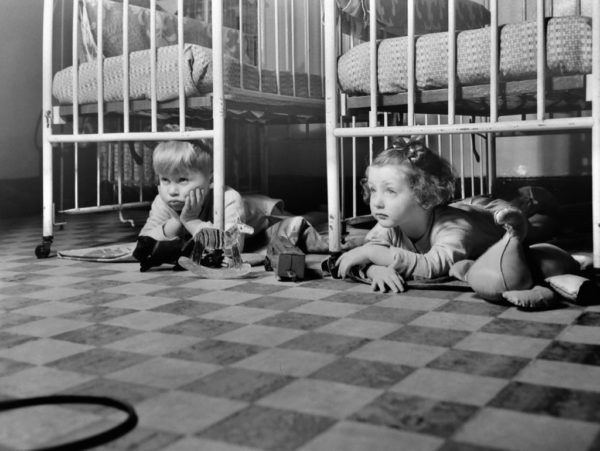
Two tots looking away, February 1942
These two little guys look like they’re comfortable and relaxed under their beds. They’ve brought some playthings with them, so maybe it’s their home away from home. They’re not looking at the camera, which is kind of surprising since the camera is pretty close. They’re too young to follow directions (“look to your right, casually and wistfully”). And there were no TV screens or similar attractions to mesmerize them in those days. But my father had two tots of his own at home in 1942, so maybe he was relaxed with these little ones, and that let them be relaxed with him.
The pictures above and below – four tots in all – were taken at the Israel Orphan Asylum. There were a number of different Jewish orphanages in Brooklyn and Manhattan in the thirties, but they were hit by the Depression just like everyone else. Contributions decreased while numbers of orphaned children, or children in need of surrogate care, increased. By about this time, 1942, many homes had been forced by finances to close, moving their children to foster care or returning them to parents or relatives. Some homes – including this one – carried on with enough financial and human support to provide what looks to be a decent environment.
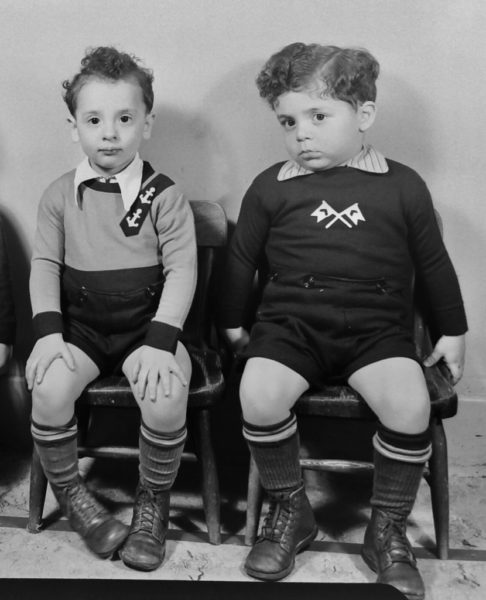
Two tots looking right at you, February 1942
These two are real lookers. They’re staring straight at the camera with a mix of laser focus and indifference. The curly hair and dark eyes are their specific version of 3-year-old-adorable. Again, my father’s manner of getting his subjects’ attention eludes me. There are five or six other shots just like this, with small kids in pairs or trios, all about three years old, most looking at the camera, though not always as intensely as these two. They’re all apparently comfortable – with each other, their surroundings and the cameraman – and are certainly well cared for.
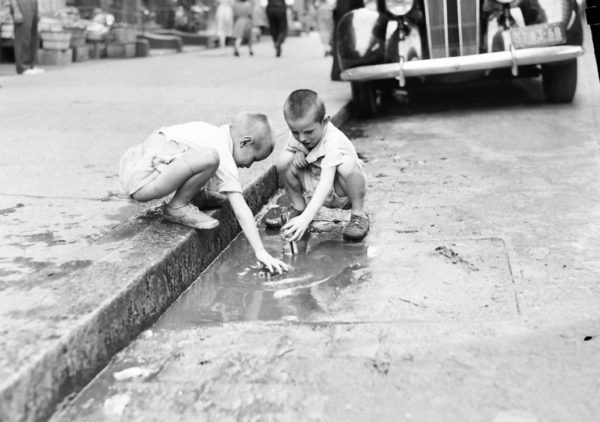
Two boys and a puddle, mid-1930s
What more do they need? Put these two young boys outside and they’ve found something to play with — in this case, mud and water. Stereotype? No doubt.
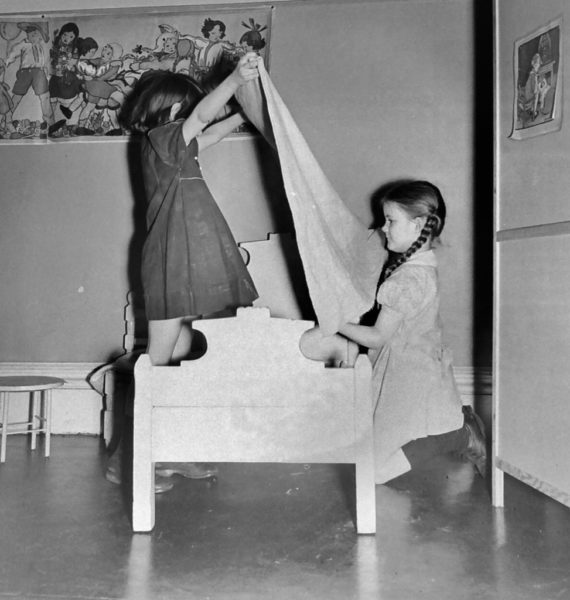
Two girls and a house, early 1940s
What more do they need? Put these two young girls together and they’ve found something to play with — a household activity that they can do together, in this case. Stereotype? No doubt.
Do both of the stereotypes have a germ of truth? Probably. If so, is that germ of truth cultural or “natural?” I won’t go there. But this comparison isn’t very fair. The boys are unstructured, finding something to do on a city street. Plenty of girls would also make their way to a puddle. The girls are in a girls’ school, about 80 years ago, with at least some inclination toward standard gender roles of the time.
When I realized how readily these two pictures spoke to opposite gender stereotypes, I didn’t resist the temptation to point it out and question it. But in fact, as always, I initially chose the pictures because they are attractive and interesting on their own, independent of each other. I hope you enjoy them for that reason too.
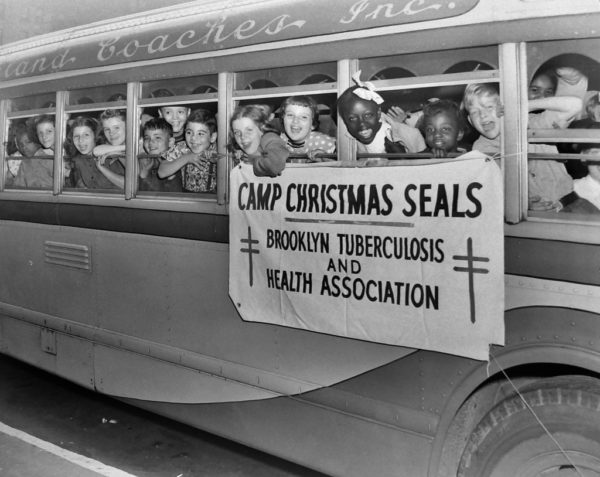
Dozens of joyful kids on a bus, June 26, 1947
Yes, I know. This picture isn’t of a pair of people — it shows a whole busload. It will be true to the theme of the week in a moment, but first some background: Tuberculosis was a significant problem in 1947 in Brooklyn. The recently discovered antibiotic cure had not yet been widely used. People living in close quarters were particularly vulnerable, which obviously included thousands of children living in crowded homes and neighborhoods.
Most healthy people infected with the bacteria that cause TB do not develop active disease, but those in a weakened or compromised condition are more likely to become sick. That also applied disproportionately to children with poor living conditions. Christmas Seal drives were a major fundraising mechanism for the battle against the disease, and one of the things done with the money was to send hundreds of kids away each year for several weeks of fresh air, physical activity, healthy diets and excellent living conditions. This bus was about to leave to take these clearly very happy kids to a wonderful and healing vacation.
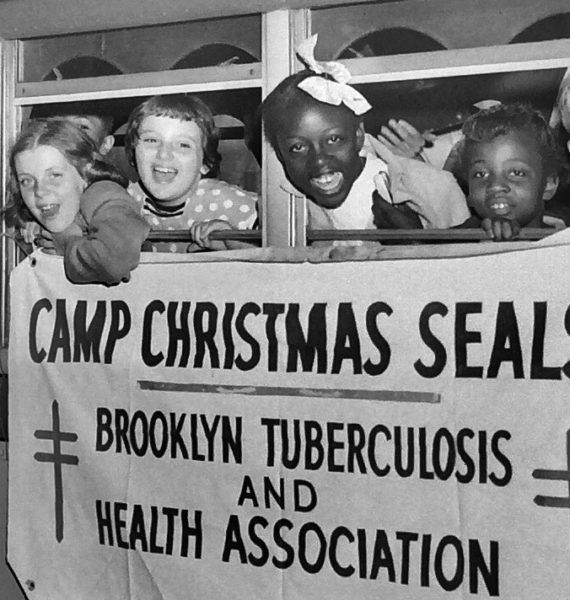
Four joyful kids on a bus, June 26, 1947
Now for the pairs. When you zoom in on something and take a closer look, a lot more is revealed than is apparent from afar — that’s what happens here. It would be great to not even feel the need to recognize that two Black kids and two White kids were part of the same social/health program. But unfortunately, that wasn’t the norm, especially more than 70 years ago.
This picture documents that in 1947 it was possible in at least some organizations to integrate groups, even in relatively unstructured and close environments like a summer sleep-over camp. This organization – Camp Christmas Seals, supported in part by Methodist camp services – was able and willing to accept both White and Black children, apparently without fuss or controversy. Some organizations were ahead of their time, behaving in ways we still wish some of today’s groups and activities could practice.
Coincidentally, this joyous bus ride took place two months and 11 days after Jackie Robinson made his major league debut right nearby in Ebbets Field.
An index of Kaufman’s Brooklyn posts may be found here.
Irving Kaufman’s profile may be found here.
I invite you to submit comments, memories, images of Brooklyn, and especially any additional background information you can supply about the photos posted here to [email protected] I’d also be glad to supply information about buying prints of any of the images seen here. Many of my father’s images are also available for viewing and purchase at http://yourartgallery.com/irvingkaufmanstudios. All prints purchased will be the product of professional scanning and editing.
"six" - Google News
June 23, 2020 at 12:01AM
https://ift.tt/3fOvPXT
Kaufman's Brooklyn: Six photos of 'Small people in pairs' - Brooklyn Daily Eagle
"six" - Google News
https://ift.tt/3dcBbL9
https://ift.tt/2Wis8la


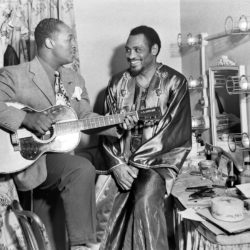


No comments:
Post a Comment